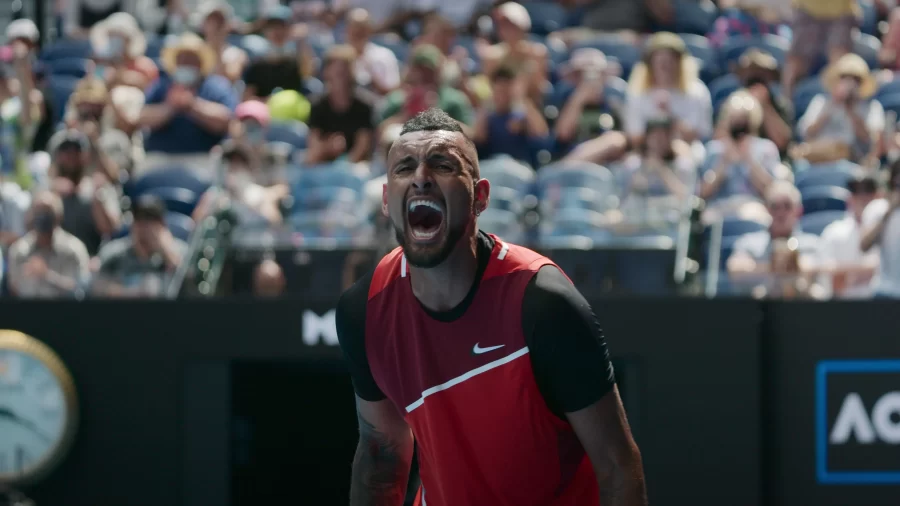Netflix’s new “Break Point” scores big
Australian male tennis player Nick Kyrgios, who is featured on the Netflix show “Break Point,” roars in excitement after an intense match.
February 7, 2023
In the game of tennis, break points require the returner to win against their opponent’s serving game. This is a tricky feat, especially in the professional realm when the ball on an average serve hurls towards a returner at 120 mph in the blink of an eye. However, the term break point can carry a separate meaning, like reaching your breaking point. Although they have different meanings, both occur in the sport and are presented in the new Netflix documentary series “Break Point.”
“Break Point” is a recently released show that follows the top men and women tennis players from around the world and takes viewers behind the scenes to witness their lives on and off the court. The show is split into two parts, with the first six episodes released in January and the next part set to return service sometime in June. It summarizes the highest-tier tennis events in the world during the 2022 season from the Australian Open in Melbourne to the French Open in Paris.
Most tennis fans have grown up watching legends such as Serena Williams, Roger Federer, Novak Djokovic and Rafael Nadal and have been mesmerized by their jaw-dropping dominance on court. Over the last 77 grand slams, 63 have been won by Federer, Djokovic or Nadal. But like everything else, good times will end: last year, Williams and Federer hung up their rackets for good, and the other two are in their mid-30s, the time when discussion of retirement looms. Because of this, the documentary hopes to introduce the new, rising stars of the game, as the sport is constantly evolving with new talent.
This isn’t the first time Netflix experimented with sports docudrama, as their first one, “Formula One: Drive to Survive,” became an instant hit and generated a massive volume of new F1 fans around the world. In fact, the producers for “Break Point,” James Gay-Rees and Paul Martin, are the same producers for “Drive to Survive,” and Netflix hopes they can generate the same success considering the fact that tennis viewership has been declining over the recent years. However, that spark isn’t there yet, and it’s not because of the sport itself; it’s the show.
For viewers who are unfamiliar with the sport, the show is perfect for getting introduced to tennis, especially when some scenes describe how the scoring system works and what the grand slams are. However, avid tennis fans have been disappointed with how the show didn’t include critical events during the tournaments nor cover much of the behind-the-scenes content that dives more profoundly than what the scoreboard reads. The scoreboard could read 5-4, but the show doesn’t explain how being 5-4 down is a lot worse than being 5-4 up while your opponent is serving (the first means your opponent is more likely to win the set after their service game because they broke your serve, while the latter suggests everyone is holding serve, as in no one has broken serve).
There are always multiple sides to a story, yet “Break Point” fails to present that narrative. Sure, the show covers exclusive interviews and off-the-court moments, but when they summarize most tournaments, they forget to cover important events during the tournament that don’t involve the featured players.
Not presenting all sides of the story, especially those of Djokovic, Federer and Nadal, is villainizing them in some way. Nadal is featured a lot of times as the Voldemort of the sport: he’s the only one that has the power to defeat all the featured players on the show and everyone is gunning after him. Matteo Berrettini, an Italian men’s top 10 player in the world and one of the players the shows follow, is shown crushing the majority of his opponents, but then is suddenly stopped by none other than Nadal. Felix Auger-Aliassime, another top 10 player featured from Canada, is said to be playing some of the best tennis of his career, but once again, Nadal prevails over him at the French Open.
Finally, a worthy Harry Potter figure defeats Voldemort. One successful challenger, American Taylor Fritz, finally triumphs over Nadal in a second-tier tournament at Indian Wells, Calif., despite fighting off a foot injury hours before the match. However, the show fails to address Nadal’s grueling three-hour match the day before and how after the match with Fritz, his recurring foot injury prevents him from playing for six to eight weeks.
The show is trying to showcase the new generation and express their frustration with the Big Three and their dominance, but it should include their rivals, or else it feels like a misrepresentation of the sport.
Although the show has its flaws, it’s still a worthwhile watch. What’s great is how it is able to cover the hidden side of tennis where fame, private jets and money is not a luxury everyone can afford. Only the top one percent of players on tour get those perks. As Fritz said, “every week you’re a loser.” Winning is an addiction for players, and mental health becomes a major issue because of that. Australian player Nick Kyrious explains how years ago there would be times when the night before a match he would be at bars partying and his friends would put a tracker on him in order to find him. Greek player Maria Sakkari describes how she couldn’t sleep for three days straight after choking a few match points during a crucial match.
Overall, “Break Point” is a good start to a show that hopes to revitalize a sport. Obviously, there is room for improvement: if the show focuses on Nadal a lot, maybe include more of his side of the story or persuade him to join the show. The show should definitely strive to make more people become tennis fanatics, but just make sure to do it right.



